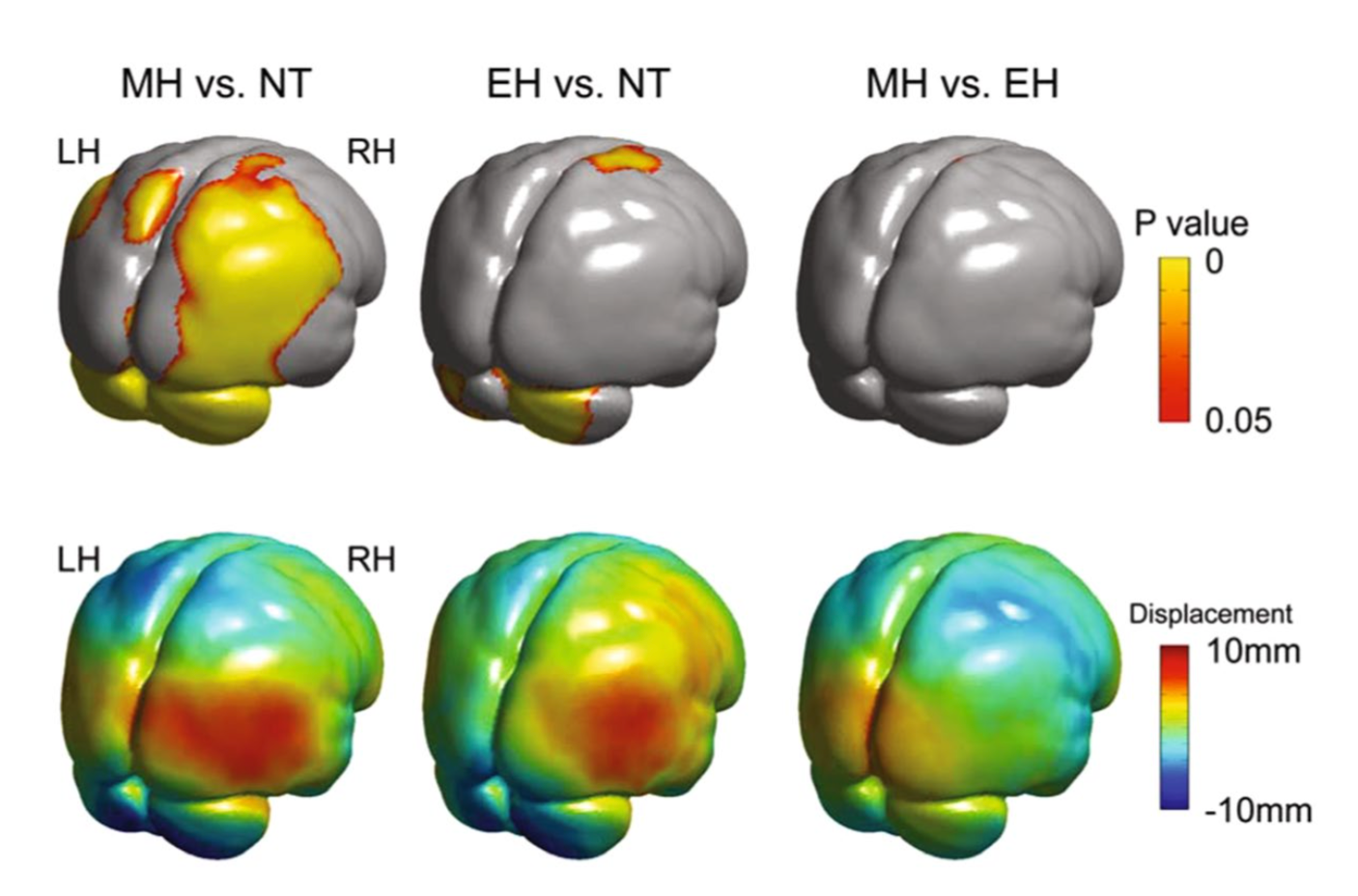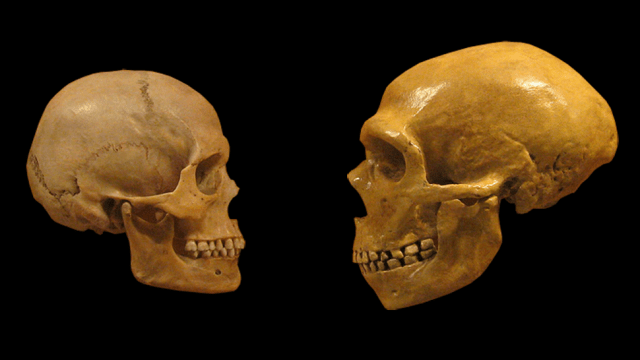Using computers and MRI scans, researchers have created the most detailed reconstruction of a Neanderthal brain to date, offering new insights into the social and cognitive abilities of these extinct humans. But as to whether these characteristics were responsible for their ultimate demise remains an open question.
Left: Skull of Homo sapiens. Right: Skull of Neanderthal. Image: HairyMuseumMatt/Wikimedia Commons
New research published this week in Scientific Reports suggests that important differences in cognitive and neural function between Homo sapiens and Neanderthals led to differences in behaviour which may have resulted in the conditions under which anatomically modern humans succeeded and Neanderthals failed some 45,000 years ago.
To reach this conclusion – and in one of the first studies of its kind – scientists conducted a comparative analysis of Neanderthal and early modern human skulls to infer brain function. But because no other archaeological evidence was provided to bolster the case, and because the shape and size of brains cannot be definitively tied to cognitive capacity and behaviour, the question of what caused Neanderthal extinction remains very much unsettled.
The story of the Neanderthals has puzzled archaeologists and anthropologists ever since the first skeleton of this species was uncovered in 1829. Despite years of research and speculation, we still aren’t sure what went wrong for the Neanderthals, who lived in Europe and Asia for a whopping 200,000 years, much of it during the Ice Age.
At the same time, scientists aren’t entirely sure what went right for Homo sapiens. So when it comes to explaining their failure and our success, it’s fair to ask: What were the differences that made the difference?
Perhaps there were differences in how the two species were able to adapt to rapidly changing climatic and environmental conditions. Or maybe it had to do with differences in technological, social and economic systems, or differences in foraging and hunting strategies. It’s possible that Neanderthals had inferior or limited communication skills, or that Neanderthals were either absorbed or wiped out by early modern humans.
These theories are all fascinating and provocative in their own right, but the ultimate reason remains unclear.
The idea that behavioural differences may have had something to do with it, however, is not outlandish. Working under the assumption that behaviour is a function of cognitive and neurological capacities, a team of researchers led by Naomichi Ogihara from Keio University in Japan set out to model the brains of Neanderthals, early anatomically modern humans, and living humans to infer possible functional differences between the two.
Prior to this work, scientists had analysed the differences between Neanderthal and modern human brains, but this is the first study to reconstruct brains for the purpose of postulating possible functional differences.

Top: Computer reconstruction of Neanderthal brains. Middle: Typical modern human brains. Bottom: Reconstructed Neanderthal brains with regions highlighted. Image: Takanori Kochiyama et al., 2018
Indeed, though scientists have many Neanderthal skulls to work with, none of them contain actual brains, making it difficult to know what the inside of their heads actually looked like. The next best option, therefore, is to look at their fossilised skulls and try to figure out the shape, size and orientation of the Neanderthal brain.
To do this, Ogihara’s team created virtual three-dimensional “casts” of brains using data derived from the skulls of four Neanderthals and four early modern humans (the skulls used in the study dated from between 135,000 and 32,000 years ago). This allowed the researchers to reconstruct and visualise the 3D structure of the brain’s grey and white matter regions, along with the cerebrospinal fluid regions.
Then, using a large dataset from the Human Connectome Project, specifically MRI brain scans taken of more than 1180 individuals, the researchers modelled the “average” human brain to provide a kind of baseline for the study and allow for the comparative analysis.
Using this method, the researchers uncovered “significant” differences in brain morphology. Even though Neanderthals had larger skulls, and thus larger brain volume overall, H. sapiens had a proportionately larger cerebellum, the part of brain involved in higher levels of thinking and action. Modern humans also featured a smaller occipital region in the cerebrum, which is tied to vision.
Looking at these differences, the researchers inferred such abilities as cognitive flexibility (that is, learning, adaptability, and out-of-the-box thinking), attention, language processing, and short-term and long-term memory. Homo sapiens, the researchers concluded, had better cognitive and social abilities than Neanderthals, and a greater capacity for long-term memory and language processing.

Comparisons of the brain surface shape among Neanderthal, early Homo sapiens, and modern Homo sapiens. Image: Takanori Kochiyama et al., 2018
“This team has found significant differences between Neanderthal brains and modern human brains, specifically in brain areas we associate today with human capacities for language, social cooperation, and memory capacity,” Lana Ruck, a doctoral student in the Cognitive Science Program at the Department of Anthropology at Indiana University, told Gizmodo.
“Because these are all very adaptive behaviours which have expanded in humans relative to other species today, it is interesting to study how these brain areas differed between the hominins.”
Ruck, who wasn’t involved in the new study, said this is especially interesting in the case of the Neanderthals, because the two species actually interacted with with each other on the landscape, and because differences in cognition are a big hypothesis for why the Neanderthals went extinct, but Homo sapiens did not. As the researchers concluded in the study:
Thus, the differences in neuroanatomical organisation of the cerebellum may have resulted in a critical difference in cognitive and social ability between the two species. Consequently, ability to adapt to changing environment by creating innovation may have been limited in [Neanderthals] and this difference possibly affected their chance of survival and drove the replacement process.
Neuroscientist Kari L. Allen, an assistant professor at Washington University’s School of Medicine in St Louis, said the new paper is an intriguing step forward in terms of incorporating our knowledge of modern brain function into fossil analyses. But she said more work on the connection between brain size, shape and function is required before we can confidently interpret the evolutionary impact of these differences between Neanderthals and humans.
“The authors rely on the premise that bigger is better and that shape of the brain surface can be used to interpret the size of brain components,” Allen told Gizmodo.
“One thing to keep in mind is that the overall shape of brain is almost certainly a compromise of multiple factors and some of these are likely to have little impact on cognition. For example, brain size and shape is to some degree constrained by body size and the size and shape of the facial skeleton. So the connection between shape and cognition is difficult to assess.”
Indeed, the notion that we can extrapolate cognitive capacities and behaviour by modelling the shape of brains in a computer is a tenuous proposition at best.
“This is probably the most important question here, because it’s a very contentious topic in the field today: What can you tell about a species’ cognitive capacities if you only have their brains or skulls?” asked Ruck.
“Although the authors claim that cerebellar volume correlates with increased executive functions, including attention, inhibition, speech comprehension and production, and working memory, this does not necessarily correspond to deficits in human subjects with smaller cerebellums in their sample, since the Human Connectome Data is of healthy adults.”
By the same token, Ruck said it may be a stretch to posit that smaller cerebellums and reduced social and linguistic capacities in Neanderthals had negative consequences for the survival of the species. These shortcomings aside, Ruck said the new study is one of the very earliest attempts to predict brain surfaces and anatomy of extinct human ancestors directly from 3D computer models, “so in that sense, it’s important”.
[referenced url=”https://gizmodo.com.au/2017/10/neanderthals-with-disabilities-survived-through-social-support/” thumb=”https://i.kinja-img.com/gawker-media/image/upload/t_ku-large/esnww6pfnjdash1phoj7.png” title=”Neanderthals With Disabilities Survived Through Social Support” excerpt=”A re-analysis of a 50,000-year-old Neanderthal skull shows that, in addition to enduring multiple injuries and debilitations, this male individual was also profoundly deaf. Yet he lived well into his 40s, which is quite old by Paleolithic standards. It’s an achievement that could have only been possible with the help of others, according to new research.”]
As a final note, it’s important to point out that brain function and intelligence are almost always a very small part of the story. Modern culture emphasises – and even fetishises – intelligence, so it’s no surprise that some scientists attribute it to the success of early modern humans.
But an analysis such as this one doesn’t tell us anything about the culture, oral tradition and social networks that may have helped Neanderthals make up for any cognitive “deficiencies” compared to H. sapiens. At the same time, this study on its own cannot tell us if these differences had anything to do with Neanderthal extinction.
Without more information, such as archaeological or genetic evidence, the question of Neanderthal extinction remains unresolved.
